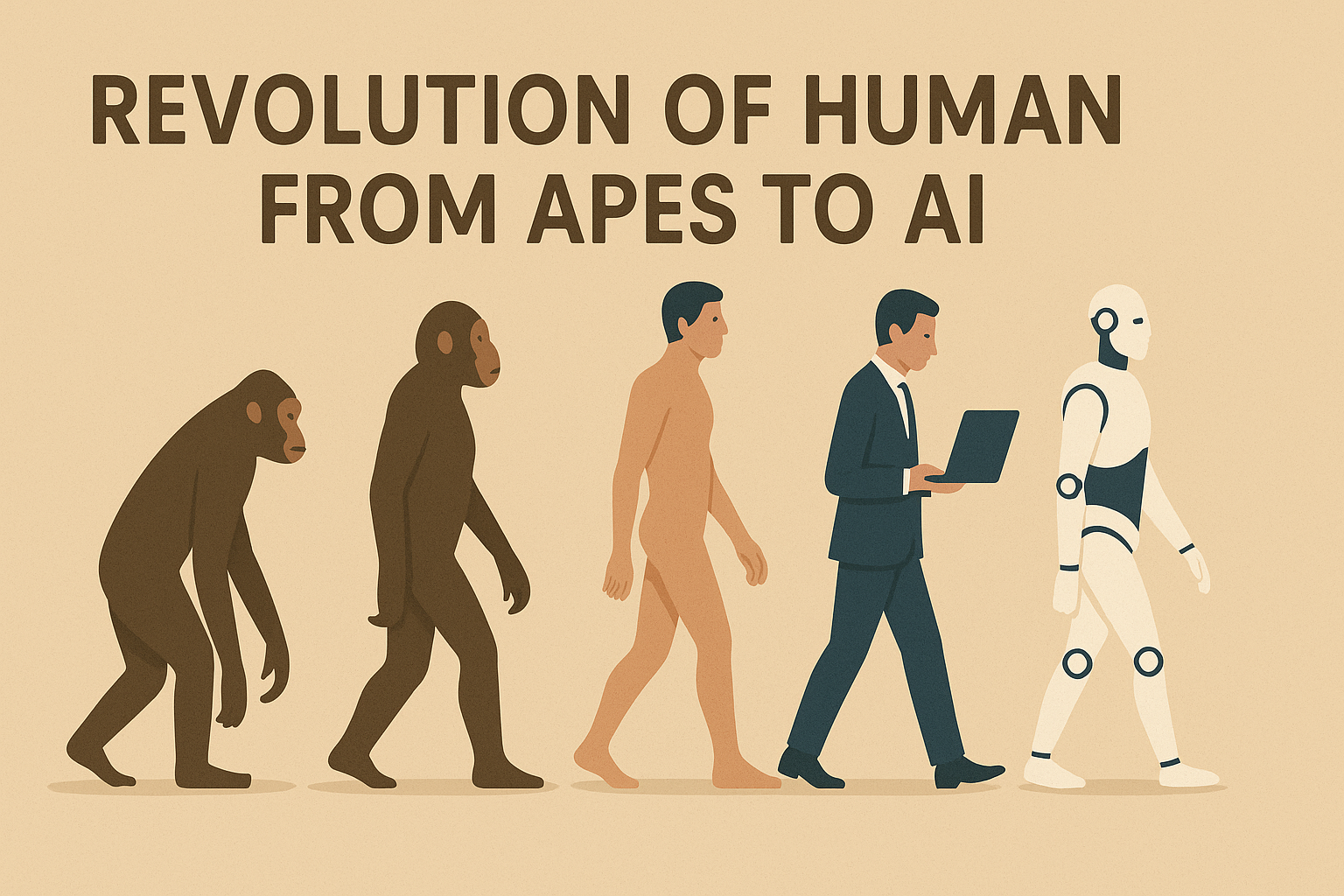From Apes to AI: The 7-Million-Year Journey of Humanity
Humanity’s story is one of relentless transformation—marked by biological evolution, cultural revolutions, and technological leaps. Over the span of 7 million years, our ancestors evolved from tree-dwelling primates to the architects of artificial intelligence. This journey is not just a tale of survival but a testament to human ingenuity, adaptability, and the unyielding quest for progress.
In this blog post, we’ll explore the key milestones that shaped our species, from the first steps of early hominins to the rise of AI. Each phase reveals how innovation and adaptation propelled humanity forward, reshaping our world—and ourselves—in the process.

1. Our Primate Origins: The Dawn of Humanity (7 Million Years Ago)
Who Were the First Ancestors?
Around 7 million years ago, the evolutionary paths of humans and chimpanzees diverged. The earliest hominins—our distant ancestors—began walking upright, a defining trait that set the stage for everything that followed.
Key Early Hominins:
- Sahelanthropus tchadensis – One of the oldest known hominins, with a skull suggesting a mix of ape and human-like features.
- Ardipithecus ramidus – Showed early signs of bipedalism while still retaining tree-climbing adaptations.
- Australopithecus afarensis (e.g., “Lucy”) – A more advanced walker, providing crucial evidence of upright locomotion.
Why Was Bipedalism a Game-Changer?
Walking on two legs was revolutionary because it:
- Freed the hands for tool use, carrying food, and crafting weapons.
- Improved energy efficiency, allowing early humans to travel longer distances.
- Enhanced visibility over tall grasses, helping spot predators and prey.
This shift didn’t just change how we moved—it altered how we interacted with the world, paving the way for future innovations.
2. The Rise of the Homo Genus: Toolmakers and Fire masters (2.5 Million Years Ago)
As early humans grew more skilled, their ability to shape their environment set them apart from other species. Tools and fire became not just survival aids, but powerful forces driving cooperation, innovation, and social complexity.
Homo habilis: The First Toolmakers
Nicknamed the “handy man,” Homo habilis crafted the earliest stone tools. These simple but effective implements allowed:
- Butchering meat – Accessing protein-rich diets.
- Breaking bones for marrow – Maximizing nutrition.
- Shaping wood – Creating digging sticks and other tools.
Homo erectus: Mastering Fire
Later, Homo erectus harnessed fire, one of humanity’s most transformative discoveries. Fire enabled:
- Cooking food – Making it safer and easier to digest.
- Survival in colder climates – Expanding migration possibilities.
- Social bonding – Nighttime gatherings likely boosted communication and culture.
Fire didn’t just provide warmth—it ignited human progress.
3. The Birth of Modern Humans and Culture (300,000 Years Ago)
Homo sapiens: The Cognitive Revolution
Anatomically modern humans appeared ~300,000 years ago, but the real breakthrough came ~70,000 years ago with the Cognitive Revolution. The mind became the most powerful tool. Creativity, communication, and cooperation began to shape cultures that would leave lasting marks on the world.
- Complex language – Enabling abstract thought and storytelling.
- Art and symbolism – Cave paintings, jewelry, and rituals.
- Large-scale cooperation – Strengthening social structures.
The Great Human Migration
Starting ~60,000 years ago, Homo sapiens spread from Africa across the globe, adapting to diverse environments and outcompeting other hominins like Neanderthals. This migration led to:
- Cultural diversification – Different societies developed unique traditions.
- Advanced hunting strategies – Such as spear-throwing and traps.
- Settlements – The first steps toward permanent communities.
4. The Agricultural Revolution: Settling Down (10,000 Years Ago)
The shift from hunter-gatherers to farmers was a turning point in human history. Communities that once roamed freely now had to share and manage land, water, and harvests together. With shared resources came disagreements, and early forms of workplace conflict began to emerge in the fields and granaries.
Why Did Agriculture Change Everything?
- Food surplus – Allowed populations to grow.
- Permanent settlements – Leading to villages and cities.
- Specialized labor – Not everyone had to farm; artisans, leaders, and scholars emerged.
Downsides of Farming?
While agriculture brought stability, it also introduced:
- Social hierarchies – Wealth and power disparities.
- Disease – Denser populations led to epidemics.
Still, this revolution laid the foundation for civilization as we know it.
5. Civilization and Technological Innovation (5,000 Years Ago – Present)
As humans gathered in thriving cities, ideas flowed faster than ever before. Each new invention built upon the last, sparking an unbroken chain of innovation that continues to shape our modern world.
With cities came rapid advancements:
- Writing systems – Record-keeping and literature.
- Metallurgy – Bronze and iron tools revolutionized warfare and construction.
- Science & Philosophy – Ancient Greeks, Chinese, and Indians explored math, astronomy, and medicine.
Fast-forward to the Industrial Revolution, and humanity unlocked:
- Steam engines – Powering factories and transport.
- Electricity – Lighting up cities and enabling modern tech.
- Telecommunications – Connecting the world.
6. The Digital Age: Computing and Connectivity (20th Century – Present)
The rise of digital technology transformed how we live, work, and connect with each other. From massive computers to smartphones, our world became instantly accessible and endlessly interconnected.
The 20th century brought the digital revolution:
- Computers – From room-sized machines to pocket-sized smartphones.
- The Internet – A global network transforming communication, business, and education.
- Smartphones & AI Assistants – Putting vast knowledge at our fingertips.
7. Artificial Intelligence: The Next Frontier (21st Century & Beyond)
Artificial Intelligence is rapidly changing the boundaries of what machines—and humans—can achieve. As this technology advances, it presents both incredible opportunities and complex ethical challenges for society to navigate. Today, AI is reshaping humanity’s future.
What Can AI Do?
- Machine learning – Adapting and improving without explicit programming.
- Healthcare breakthroughs – Faster diagnostics and personalized medicine.
- Self-driving cars – Revolutionizing transportation.
Ethical Questions We Must Face:
- Will AI replace jobs? (Yes, but it will also create new ones.)
- How do we prevent bias in AI? (Transparent algorithms and ethical guidelines.)
- Could AI surpass human intelligence? (A topic of fierce debate.)
Conclusion: What Does Our Journey Tell Us?
From apes walking upright to AI writing poetry, humanity’s journey is a saga of adaptation, innovation, and relentless curiosity. Each leap—whether biological, cultural, or technological—has brought both challenges and opportunities.
As we stand at the brink of an AI-driven future, understanding our past helps us navigate what comes next wisely and ethically.
How Can You Engage with This Story?
- Read books like Sapiens by Yuval Noah Harari.
- Visit museums showcasing human evolution.
- Experiment with AI tools to see the future in action.


Comments